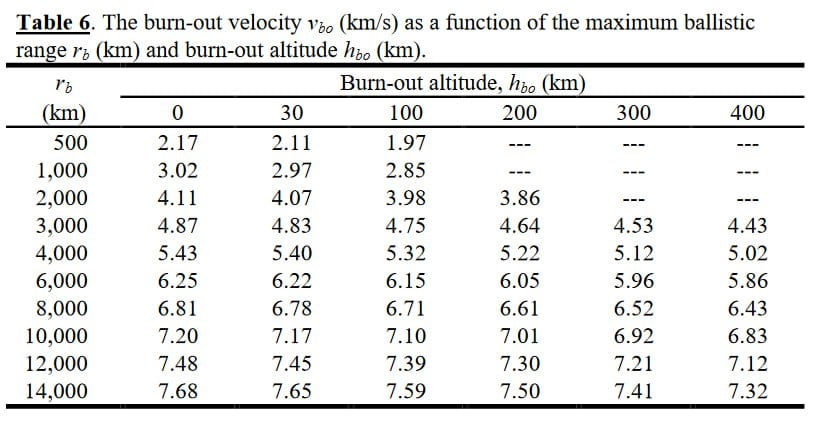On possibility of intercepting russian ballistic missiles in the ascent phase with ground launched interceptors.
Hear me out. Russians have missile silo fields in Povolzhya, ~~480 km from Ukraine, and near Murmansk, a couple hundred kilometers from Finland (at most; didn’t check precisely because irrelevant, less than 480 km). Of course, russians also have mobile launchers, submarines and other launch sites, but one problem at a time. I will prove the possibility of intercepting of Povolzhya missiles on ascent, and Murmansk ones will be obvious then.
Ascent phase of ICBM flight takes about 2-3 minutes, assume 200s, maybe more, and ends at height of approximately 150-200 km, worse case scenario 100. Let’s say we detect the missiles 20s after launch at the height of 15 km via a ground based radar installation in eastern Ukraine. At the height of 15 km, missile will be visible over the horizon at a distance of 437 km. It’s less than 480, but keep in mind that after launch missile travels some distance to the west, getting closer, and we have other means of detection, and surprisingly, we actually have some time to spare. If we assume an interceptor traveling at 3400 m/s (marginally slower than Sprint, actually), it will fly 430 km in 126s, add 3.4s for accelerating to speed at 100g (sprint numbers, through Sentinel LOADS reportedly managed 400 g). 126+3.4+20= 150s, from “200 and maybe more” the ascent phase of an ICBM typically takes. Now, of course, it is preferable to take the missile out earlier, before all the stages are separated, and to have some spare time, and interceptor launch won’t be instant, so likely our margins are lower, but it’s feasible, still. Now, is such a missile technically possible? I would argue yes, actually, it’s easier than one might think.
For one, the target is constantly getting closer. So, it doesn’t need to have a 480 km range, likely something like 300 km would do, didn’t yet calculate the precise numbers, need to find/model russian missile flight details. Sprint had like, 48 km range, so maybe just adding a new first stage (making it a three stage system) would do. Consider also that this is interception range, not ballistic range of the missile’s flight, restricted by other factors (aerodynamic control surface effectiveness, for once, radio command range). 3400 m/s speed should give a ballistic flight range of about 1000-1500 km (depends on the burnout altitude, and for sprint it’s like 0), and obviously apocenter of the trajectory wouldn’t be 50 km in.
Then, as the interception would need to happen at 100-200 km, not sub 60, majority of missile’s flight would be in upper atmosphere, where air resistance and heating are far less severe. Perhaps the missile could accelerate faster in upper atmosphere, to mach 12-15 (US HGV-2 glider demonstrated controlled high atmospheric flight at Mach 20), which would buy time for a slower ascent above 60 km, evening the thermal loads, so it wouldn’t need to glow.
Of course, I don’t propose using literally Sprint missiles or their copies. For once, radio command would probably be impractical beyond some range, and I’m not sure radar guidance is feasible, so perhaps just launching it at a predicted point in target’s ballistic path could work, or it could not, this aspect requires some consideration. I propose keeping the neutron warhead; it would lack precision for anything else. And, of course, if interception is possible from Ukraine - it is possible from Finland, maybe even with something closer to original Sprint, considering the low distance.
In conclusion, I think this is a feasible concept worth exploring. Such interception would cripple russian nuclear attack, through not completely negate it.
Pictured: me when when nukes

I’m no expert, but your post looks to me like it might be too credible for this sub (that’s a compliment, BTW).
def not a rule 6 violation
ah yes let’s just take one of the most aggressively optimised missile ever and extend its range 10x
Too many assumptions to be credible. This community prefers images of bricks instead of wall of text with numbers, but these numbers seems made up
Honestly, please submit more numbers (made up or otherwise). We enjoy the schizos who invent new schools of math because God revealed it to them in a dream and the autistic obsessors who crunched all the numbers to show us why their beloved weapon system is based.
It’s non-credible missile defence.
The numbers are, however, not made up, and that’s what makes the post funny in my opinion. For example here is a table for ballistic ranges derived from missile velocity; of course, like, it’s the roughest of estimations, because Sprint burns out very quickly and also would possibly slow down quicker than a TBM due to base drag, this could be mitigated, but whatever.

My thoughts exactly. There’s math and shit and to my smooth brain, seems pretty credible.
Nuclear war is illegal anyway so Russia literally can’t fire its nukes?
That’s a good point. America really got put through the international wringer last time nukes were used.
I’m having absolutely no calculation, data or knowledge about missiles, but I can assume that fail rate of such ICBM would be greater than the hit rate of the proposed interceptor, therefore we can eliminate that stage completely and wait for the ICBMs to destroy themselves. Highly cost effective, nod nod the world is saved!
What if we kissed above the missile silo fields of Povolzhya at 3400 m/s 👀
w<
>w<
So you might be interested in the missile defense system.
As far as I know the US Missile Defense Agency is the only organization that has done any serious work on ballistic missile interception. A lot of time, research, effort and money have been put into this since the 1970s, and it does actually work (that is, it is practically possible to track ballistic missile launches and intercept them before they reach their targets).
It’s actually a lot easier to do this during the mid-course flight, not during the launch (boost) phase. During boost the missile is still accelerating and possibly changing trajectory while it has fuel, which makes its flight path harder to predict and therefore harder to hit. After boost the missile is purely ballistic (no more fuel) so its path is predictable.
There are currently two US radar facilities, one in Poland and one in Romania, that basically just watch Russia for missile launches all the time.
The inherent issue with a missle defense system is that they work on paper if you don’t look at any outside context. Obviously no missle defense system is perfect, so they can’t really protect you from a first strike. But they’re great at protecting you from a retaliatory strike after you have destroyed most of your enemy’s military infrastructure.
So if my enemy now has the means to wipe out my ability to assure mutual destruction, i have two options: hope that they dont hit me with a first strike, or launch my own first strike, overwhelming their missle defense system, and accept the consequences that come from that.
The inherent issue with a missle defense system is that they work on paper if you don’t look at any outside context.
This is why I said it is practically possible, as in not theoretically. The system has been real-world tested against empty ICBMs:
In 2020 an Aegis BMD-equipped destroyer successfully intercepted a simple intercontinental ballistic missile (ICBM)-threat representative target with a SM-3 Block IIA missile, illustrating how the system could be used in a layered missile defense architecture, enhancing U.S. homeland missile defense. ref
they can’t really protect you from a first strike.
Why do you think so? The whole point of having radar observation stations is that the missiles can be detected and tracked as soon as they launch, and intercepted before they come down.
An ICBM is a big fucking rocket. You can’t hide the engine burn, it’s just like launching any space rocket - everyone will know as soon as you light it off, and it’s not going to reach its target instantly. Plenty of reaction time while it’s in flight.
That’s actually kind of comforting. That, plus my unconscious ignorance, combine to give me a sleeping-bag-on-a-cold-night feeling! Let’s maintain this for as long as possible!
Exoatmospheric interception is convinient, but can be made much harder with decoys, and those decoys can be very compact (a.e. inflatable warhead imitators), US BMD AFAIK isn’t even meant to deal with them. An ICBM deploys a “funnel” (don’t know the English technical term) of those targets along with real warheads, exactly to make interception difficult. Sprint was developed to intercept warheads below 60 km, where inflatable decoys, foil, radar reflectors etc would be either slowed down by drag way more than real warheads or burn up. Heavy decoys exist, but they take space on the missile and eat into payload weight significantly.
I took that concept and flipped it on its head, with interception happening before any decoys are released at all. Exoatmospheric interception is too credible anyway, and US already tried every whacky version of it, lol.

there’s at least one russian silo field north of Kazakh border (62nd in Uzhur), so for this plan to work we need Kazakhstan in NATO and even that is probably too far
and also how do you deal with road-mobile ICBM TELs
Break out the T-mobile derivative for those road-mobile bastards
It isn’t meant to intercept everything, just something, rest could be left to more conventional BMD. Kazakhstan in NATO sounds fun tho.
Road-mobile ICBMs, well, they are based in particular areas and Topol can only launch from a relatively small number of pre-determined sites, no idea why or on what’s the situation with Topol-M or Yars. Some are based close enough to Belarus to be in range of this proposed system, Belarus in NATO when
They only carry one warhead through, credible answer is to intercept the warheads outside the atmosphere, non-credible answer is to build a ground-to-ground strike capability into my system, then watch the launchers from orbit and strike before missiles are fully erected.
your solution to road-mobile TELs is significantly less psychotic than what was once proposed by usstratcom, namely burning entire siberian forests where these trucks could plausibly hide with megaton-range airbursts
Wait till you see the AT&T, Verizon, and T-mobile derivatives
They are slow enough to be counter-intercepted by antiair artillery








